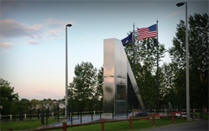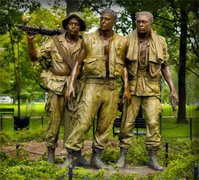|

Vietnam Wall
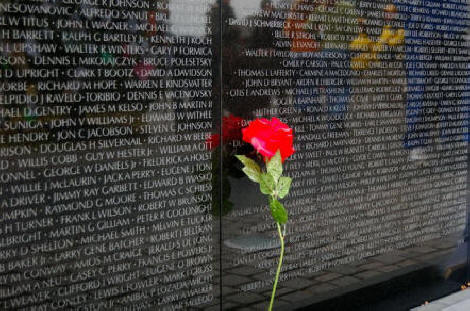 The
Memorial Wall, designed by Maya Lin, is
made up of two gabbro walls 246 feet
9 inches (75 m) long The walls are sunk
into the ground, with the earth behind
them. At the highest tip (the apex where
they meet), they are 10.1 feet (3 m)
high, and they taper to a height of
eight inches (20 cm) at their
extremities. Stone for the wall came
from Bangalore, Karnataka, India, and
was deliberately chosen because of its
reflective quality. The Lincoln memorial
can be seen in the distance. Stone
cutting and fabrication was done in
Barre, Vermont. Stones were then shipped
to Memphis, Tennessee where the names
were etched. The etching was completed
using a photoemulsion and sandblasting
process. The negatives used in the
process are in storage at the
Smithsonian Institution. When a visitor
looks upon the wall, his or her
reflection can be seen simultaneously
with the engraved names, which is meant
to symbolically bring the past and
present together. One wall points toward
the Washington Monument, the other in
the direction of the Lincoln Memorial,
meeting at an angle of 125° 12′. Each
wall has 72 panels, 70 listing names
(numbered 1E through 70E and 70W through
1W) and 2 very small blank panels at the
extremities. There is a pathway along
the base of the Wall, where visitors may
walk, read the names, make a pencil
rubbing of a particular name, or pray. The
Memorial Wall, designed by Maya Lin, is
made up of two gabbro walls 246 feet
9 inches (75 m) long The walls are sunk
into the ground, with the earth behind
them. At the highest tip (the apex where
they meet), they are 10.1 feet (3 m)
high, and they taper to a height of
eight inches (20 cm) at their
extremities. Stone for the wall came
from Bangalore, Karnataka, India, and
was deliberately chosen because of its
reflective quality. The Lincoln memorial
can be seen in the distance. Stone
cutting and fabrication was done in
Barre, Vermont. Stones were then shipped
to Memphis, Tennessee where the names
were etched. The etching was completed
using a photoemulsion and sandblasting
process. The negatives used in the
process are in storage at the
Smithsonian Institution. When a visitor
looks upon the wall, his or her
reflection can be seen simultaneously
with the engraved names, which is meant
to symbolically bring the past and
present together. One wall points toward
the Washington Monument, the other in
the direction of the Lincoln Memorial,
meeting at an angle of 125° 12′. Each
wall has 72 panels, 70 listing names
(numbered 1E through 70E and 70W through
1W) and 2 very small blank panels at the
extremities. There is a pathway along
the base of the Wall, where visitors may
walk, read the names, make a pencil
rubbing of a particular name, or pray.
Inscribed on the walls with the Optima
typeface are the names of servicemen who
were either confirmed to be KIA (Killed
in Action) or remained classified as MIA
(Missing in Action) when the walls were
constructed in 1982. They are listed in
chronological order, starting at the
apex on panel 1E in 1959 (although it
was later discovered that the first
casualties were military advisers who
were killed by artillery fire in 1957),
moving day by day to the end of the
eastern wall at panel 70E, which ends on
May 25, 1968, starting again at panel
70W at the end of the western wall which
completes the list for May 25, 1968, and
returning to the apex at panel 1W in
1975. Symbolically, this is described as
a "wound that is closed and healing."
Information about rank, unit, and
decorations are not given. The wall
listed 58,191 names when it was
completed in 1993; as of June 2010,
there are 58,267 names, including 8
women. Approximately 1,200 of these are
listed as missing (MIAs, POWs, and
others), denoted with a cross; the
confirmed dead are marked with a
diamond. If the missing return alive,
the cross is circumscribed by a circle
(although this has never occurred as of
March 2009; if their death is confirmed,
a diamond is superimposed over the
cross. According to the Vietnam Veterans
Memorial Fund, "there is no definitive
answer to exactly how many, but there
could be as many as 38 names of
personnel who survived, but through
clerical errors, were added to the list
of fatalities provided by the Department
of Defense." Directories are located on
nearby podiums so that visitors may
locate specific names.
Beginning and ending timeline for those
listed on the wall
-
November 1, 1955
– Dwight D. Eisenhower deploys
Military Assistance Advisory Group
to train the South Vietnamese
military units and secret police.
However, the U.S. Department of
Defense does not recognize such date
since the men were supposedly only
training the Vietnamese. The
officially recognized date is the
formation of the Military Assistance
Command Viet-Nam, better known as
MACV. This marks the official
beginning of American involvement in
the war as recognized by the
memorial.
-
June 8, 1956 –
The first official death in Vietnam
is U.S. Air Force Technical Sergeant
Richard B. Fitzgibbon, Jr. of
Stoneham, MA who was killed by
another U.S. airman.
-
July 8, 1959 –
Charles Ovnand and Dale R. Buis are
killed by guerrillas at
Bien Hoa while watching the film
The Tattered Dress. They are listed
1 and 2 at the wall's dedication.
Ovnand's name is spelled on the
memorial as "Ovnard," due to
conflicting military records of his
surname.
-
April 30, 1975 –
Fall of Saigon. The U.S. Department
of Veterans Affairs uses May 7, 1975
as the official end date for the
Vietnam era as defined by Title 38
U.S. Code Section 101.
-
May 15, 1975 – 18
Marines are killed on the last day
of a rescue operation known as the
Mayagüez incident with troops from
the Khmer Rouge in Cambodia. They
are the last servicemen listed on
the timeline
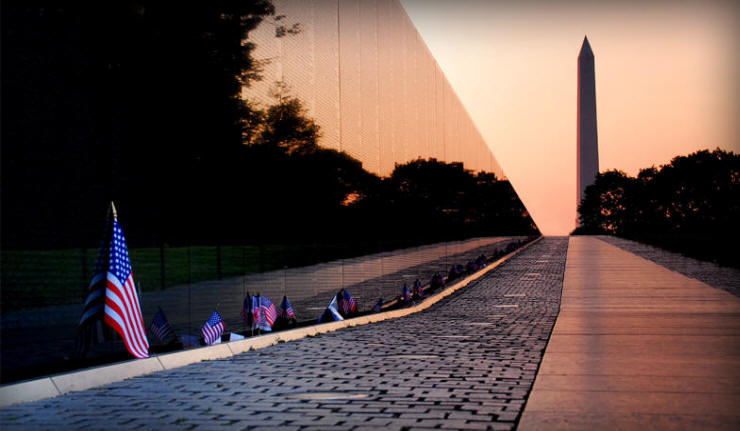
The
Vietnam Veterans Memorial is a national memorial
in Washington, D.C. It honors U.S. service
members of the U.S. armed forces who fought in
the Vietnam War, service members who died in
service in Vietnam/South East Asia, and those
service members who were unaccounted for
(Missing In Action) during the War.
The unconventionality
of the selected design was very
controversial, especially among
veterans. Many publicly voiced their
displeasure, calling the wall "a black
gash of shame." Two prominent early
supporters of the project, H. Ross Perot
and James Webb, withdrew their support
once they saw the design. Said Webb, “I
never in my wildest dreams imagined such
a nihilistic slab of stone.” James Watt,
Secretary of the Interior under
President Ronald Reagan, initially
refused to issue a building permit for
the memorial due to the public outcry
about the design.
Once the design was
realized, the overwhelming majority of
the design's critics came to appreciate
the simple beauty and emotional power of
the wall, and such controversy quickly
evaporated. In the words of Scruggs, "It
has become something of a shrine.
|
|

Interesting Stats and Update
There are 58,267 names now listed on that
polished black wall, including those added in
2010.
The names are arranged in the order in which
they were taken from us by date and within each
date the names are alphabetized. It is hard to
believe it is 36 years since the
last casualties.
Beginning at the apex on panel 1E and going out
to the end of the East wall, appearing to recede
into the earth (numbered 70E - May 25, 1968),
then resuming at the end of the West wall, as
the wall emerges from the earth (numbered 70W -
continuing May 25, 1968) and ending with a date
in 1975. Thus the war's beginning and end meet.
The war is complete, coming full circle, yet
broken by the earth that bounds the angle's open
side and contained within the earth itself.
There are 58,267 names now listed on that
polished black wall, including those added in
2010. The names are arranged in the order in
which they were taken from us by date and within
each date the names are alphabetized. It is
hard to believe it is 36 years since the last
casualties.
Beginning at the apex on panel 1E and going out
to the end of the East wall , appearing to
recede into the earth (numbered 70E - May 25,
1968), then resuming at the end of the West
wall, as the wall emerges from the earth
(numbered 70W - continuing May 25, 1968) and
ending with a date in 1975. Thus the war's
beginning and end meet. The war is complete,
coming full circle, yet broken by the earth that
bounds the angle's open side and contained
within the earth itself.
The first known casualty was Richard B.
Fitzgibbon, of North Weymouth, Mass. Listed by
the U.S. Department of Defense as having been
killed on June 8, 1956. His name is listed on
the Wall with that of his son, Marine Corps
Lance Cpl. Richard B. Fitzgibbon III, who was
killed on Sept. 7, 1965.
There are three sets of fathers and sons on the
Wall.
39,996 on the Wall were just 22 or younger.
8,283 were just 19 years old.
The largest age group, 33,103 were 18 years old.
12
soldiers on the Wall were 17 years old.
5
soldiers on the Wall were 16 years old.
One soldier, PFC Dan Bullock was 15 years old.
997 soldiers were killed on their first day in
Vietnam.
1,448 soldiers were killed on their last day in
Vietnam.
31
sets of brothers are on the Wall.
Thirty one sets of parents lost two of their
sons.
54
soldiers once attended Thomas Edison High School
in Philadelphia. Why so many from one school?
8
Women are on the Wall ~ Nursing the wounded.
244 soldiers were awarded the Medal of Honor
during the Vietnam War; 153 of them are on the
Wall.
Beallsville, Ohio, with a population of 475,
lost 6 of her sons.
West Virginia had the highest casualty rate per
capita in the nation. There are 711 West
Virginians on the Wall.
The Marines of Morenci: They led some of the
scrappiest high school football and basketball
teams that the little Arizona copper town
of Morenci (pop. 5,058) had ever known and
cheered. They enjoyed roaring beer busts. In
quieter moments, they rode horses along the
Coronado Trail, stalked deer in the Apache
National Forest. And in the
patriotic camaraderie typical of Morenci's
mining families, the nine graduates of Morenci
High enlisted as a group in the Marine Corps.
Their service began on Independence Day, 1966.
Only 3 returned home.
The Buddies of Midvale: LeRoy Tafoya, Jimmy
Martinez, Tom Gonzales were all boyhood friends
and lived on three consecutive streets in
Midvale, Utah on Fifth, Sixth and Seventh
avenues. They lived only a few yards apart.
They played ball at the adjacent sandlot ball
field. And they all went to Vietnam. In a span
of 16 dark days in late 1967, all three would be
killed. LeRoy was killed on Wednesday, Nov. 22,
the fourth anniversary of John F. Kennedy's
assassination. Jimmy died less than 24 hours
later on Thanksgiving Day. Tom was shot dead
assaulting the enemy on Dec. 7, Pearl Harbor
Remembrance Day.
The most casualty deaths for a single day was on
January 31, 1968 ~ 245 deaths.
The most casualty deaths for a single month was
May 1968 - 2,415 casualties were incurred.
Most Americans who read this will only see the
numbers that the Vietnam War created. To those
of us who survived the war, and to the families
of those who did not, we see the faces, we feel
the pain that these numbers created. We are,
until we too pass away, haunted with these
numbers, because they were our friends, fathers,
husbands, wives, sons and daughters. There are
no noble wars, just noble warriors. |
|
The Three Soldiers

This
well-known sculpture by U.S. artist and sculptor
Frederick Hart portrays three young U.S.
fighting men, completely dressed and outfitted
in uniforms and equipment used by U.S.
infantrymen in the Vietnam War. While the
military attire is meant to be symbolic and
general in nature, the personal combat equipment
displayed is actually quite specific in
representing the figures as serving in either
the U.S. Army, or U.S. Marine Corps.
|
Of the three
fighting men, the lead figure (in
the middle) represents a Marine, as
he wears a Type M-1955 body armor
vest, which was worn exclusively by
Marines in Vietnam. He is armed only
with a Colt M1911A1 .45 caliber
automatic pistol, which is carried
in a Government Issue (GI) leather
holster, on the right hip. The
holster is attached to an M-1956 GI
pistol belt, and a small GI pistol
magazine pouch is carried on the
belt's left front. The M-1911A1 .45
caliber pistol was used by Marine
enlisted, NCO, and officer ranks, so
its depiction is consistent with a
Marine of any rank. The Marine wears
no shirt, and his body armor vest
serves as his only upper-body
clothing. His other attire consists
of tropical combat trousers and
tropical ("jungle") combat boots; he
wears no headgear. Like his
comrades, he carries a GI 1-quart
canteen retained in its cover, with
two attached to his pistol belt, and
situated at the right rear hip. |
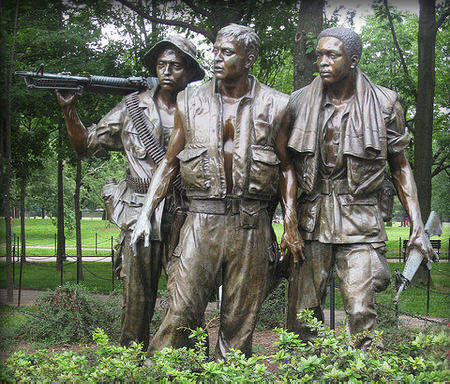
The statue,
unveiled on Veterans Day, 1984, was
designed by Frederick Hart, who
placed third in the original
memorial design competition. |
The man on
the right displays combat equipment consistent
with a U.S. Army Soldier, chiefly a Type M69
body armor vest, which was the primary armor
vest used mainly by U.S. Army personnel in
Vietnam, from about 1967 on. He also has a GI
towel draped over his neck and shoulders, which
served to absorb sweat and cushioned heavy
loads, a common practice of many Soldiers in
Vietnam. In his left hand he carries an M16A1
rifle, the main battle rifle for both Soldiers
and Marines, from about 1966 on. His uniform
consists of the tropical combat uniform (jacket
and trousers) and jungle boots. In his right
hand, he holds an M1 steel helmet with a
camouflage cover, secured with an elastic
headband (which itself retains a small bottle of
GI insect repellent). He also wears an M-1956 GI
pistol belt over his uniform jacket, which
retains a standard issue GI 1-quart canteen and
cover, situated at the left rear hip.
The man on
the left is less specific in gear and uniform,
but he appears to be a U.S. Army Soldier, as he
wears a Tropical ("Boonie") Hat, which was
widely worn by Army combat personnel in Vietnam,
and to a much lesser extent by Marines. His
uniform consists of the tropical combat jacket
and trousers, and jungle boots. This man wears
no body armor, and is armed with an M60 machine
gun, and he carries two belts of 7.62mm
ammunition draped and criss-crossed over his
torso. He is also wearing an M17 Protective
(Gas) Mask carrier on his left hip, although
U.S. troops infrequently wore or used gas masks
in Vietnam. (They were used primarily when tear
gas (CS) was employed in combat, such as by
tunnel rats, and by troops engaged in urban/city
combat, such as the Marines in Hue City in
January and February, 1968). Under his uniform
jacket, he also wears a GI pistol belt with two
GI 1-quart canteens with covers, situated at the
right rear hip.
The
statue's three men are purposely identifiable as
Caucasian (the lead man), African American (man
on right), and Hispanic (man on left). These
three figures were based on three actual young
men models, of which two (the Caucasian, and the
African-American) were active-duty Marines at
the time.
The Three
Soldiers statue was designed to supplement the
Vietnam Veterans Memorial, by adding a more
traditional component such as a statue that
depicted warriors from that respective war.
 |
|
|
 The
Memorial Wall, designed by Maya Lin, is
made up of two gabbro walls 246 feet
9 inches (75 m) long The walls are sunk
into the ground, with the earth behind
them. At the highest tip (the apex where
they meet), they are 10.1 feet (3 m)
high, and they taper to a height of
eight inches (20 cm) at their
extremities. Stone for the wall came
from Bangalore, Karnataka, India, and
was deliberately chosen because of its
reflective quality. The Lincoln memorial
can be seen in the distance. Stone
cutting and fabrication was done in
Barre, Vermont. Stones were then shipped
to Memphis, Tennessee where the names
were etched. The etching was completed
using a photoemulsion and sandblasting
process. The negatives used in the
process are in storage at the
Smithsonian Institution. When a visitor
looks upon the wall, his or her
reflection can be seen simultaneously
with the engraved names, which is meant
to symbolically bring the past and
present together. One wall points toward
the Washington Monument, the other in
the direction of the Lincoln Memorial,
meeting at an angle of 125° 12′. Each
wall has 72 panels, 70 listing names
(numbered 1E through 70E and 70W through
1W) and 2 very small blank panels at the
extremities. There is a pathway along
the base of the Wall, where visitors may
walk, read the names, make a pencil
rubbing of a particular name, or pray.
The
Memorial Wall, designed by Maya Lin, is
made up of two gabbro walls 246 feet
9 inches (75 m) long The walls are sunk
into the ground, with the earth behind
them. At the highest tip (the apex where
they meet), they are 10.1 feet (3 m)
high, and they taper to a height of
eight inches (20 cm) at their
extremities. Stone for the wall came
from Bangalore, Karnataka, India, and
was deliberately chosen because of its
reflective quality. The Lincoln memorial
can be seen in the distance. Stone
cutting and fabrication was done in
Barre, Vermont. Stones were then shipped
to Memphis, Tennessee where the names
were etched. The etching was completed
using a photoemulsion and sandblasting
process. The negatives used in the
process are in storage at the
Smithsonian Institution. When a visitor
looks upon the wall, his or her
reflection can be seen simultaneously
with the engraved names, which is meant
to symbolically bring the past and
present together. One wall points toward
the Washington Monument, the other in
the direction of the Lincoln Memorial,
meeting at an angle of 125° 12′. Each
wall has 72 panels, 70 listing names
(numbered 1E through 70E and 70W through
1W) and 2 very small blank panels at the
extremities. There is a pathway along
the base of the Wall, where visitors may
walk, read the names, make a pencil
rubbing of a particular name, or pray.
